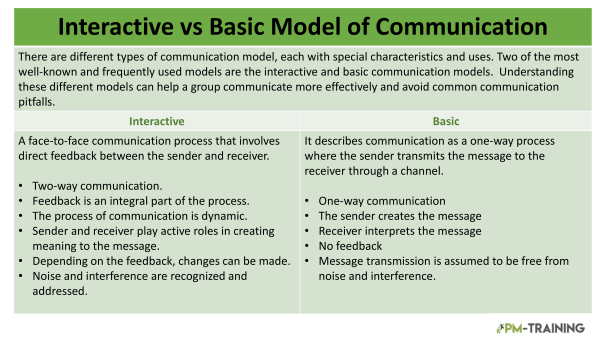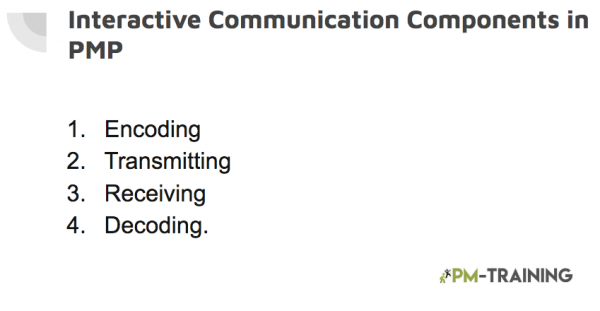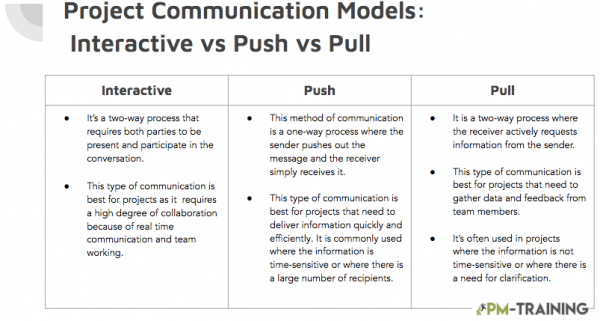The interactive model of communication is a face-to-face communication process that involves direct feedback between the sender and receiver. The interactive communication model is often used in project management because it is considered to be the most effective way to communicate.
When used in project management, the interactive communication model helps to ensure that all team members are on the same page and that everyone understands the project objectives.
- The concept of the Interactive Communication Model
- How does the Interactive Model work?
- Where to see the interactive Communication Model in project management?
- Communication Methods: Interactive vs Push vs Pull
- Why is the interactive model of communication model so important?
- How does the interactive communication model work in pmp?
- What is an example of interactive communication in pmp?
The interactive communication model is also known for its ability to resolve conflict and build relationships as it is considered to be the most effective communication model because it allows for direct feedback between the sender and receiver.
The concept of the Interactive Communication Model

The process of interactive communication is often seen as a linear process, where one person transmits a message and the other person receives it.
However, this model is not always accurate. In reality, the process of communication is often more complex and dynamic. This is especially true in the field of project management, where the goal is to create a shared understanding among team members with different backgrounds and expertise.

How does the Interactive Model work?
As we saw, Interactive communication is a process that involves two-way communication between sender and receiver where:
- The sender encodes the message, which is then transmitted to the receiver.
- The receiver then decodes the message and sends a response back to the sender.

- Encoding
The goal of communication is to send a message from one person to another and to have that message received and understood.
In order to do this, the sender (or encoder) must first encode the message into a form that can be sent.
The message is then sent through a channel to the receiver (or decoder).
The receiver then decodes the message and tries to understand it.
There are a number of elements that can affect the successful communication of a message, including the encoder, the message, the channel, the decoder, and any noise that may be present.
- Message
The message must be clear and concise in order to be effectively communicated. It is also important to consider the audience when crafting the message. The medium is the channel through which the message is communicated, and the format is the way in which the message is presented.
- Receiving
Receiving is the process of acquiring data from internal or external sources in real-time. Where data can be in the form of text, images, or audio.
It can also be in the form of project information, such as project status, tasks, or resources. The data must be interpreted and analyzed before it can be used. This is where the receiver’s expertise and knowledge come into play. After the data has been interpreted, it must be organized so that it can be used effectively. This step is known as decoding. The receiver must decide how the data will be used and what action must be taken.
- Decoding
This is the process of translating the sender’s message into an understandable form. The receivers which can be the Stakeholders or the Project Team use their own experiences, knowledge, and biases to interpret the message.
This can lead to misunderstanding, so it’s important to be aware of the potential for misinterpretation. There are a few things you can do to improve your decoding skills.
- Try to be objective and open-minded.
- Ask clarifying questions if you’re unsure about something.
- Pay attention to nonverbal cues, such as body language and tone of voice, which can give you additional information about the sender’s intended meaning.
Where to see the interactive Communication Model in project management?
Communication Methods: Interactive vs Push vs Pull
In project management, there are three main types of communication: interactive, push, and pull.
Each type has its own advantages and disadvantages, and the type of communication you use will depend on the needs of your project.

Why is the interactive model of communication model so important?
This process is important in project management because it helps to avoid miscommunication and misunderstanding. It also allows managers to gauge team members’ reactions and feedback, which can be helpful in ensuring that the project is on track. If you’re a project manager, then it’s important to understand the interactive communication model and how to use it effectively.
How does the interactive communication model work in pmp?
The sender and receiver are both active participants in the communication process. The sender encodes the message and sends it to the receiver, who then decodes the message and sends a response back to the sender. Ths interactive communication model is beneficial for project managers because it ensures that both parties are involved in the communication process which can help to avoid miscommunication and misunderstanding.
What is an example of interactive communication in pmp?
For example, imagine during a meeting. This type of communication can happen when there are real-time responses between two parties involved as the sender ensures the receiver has gotten the message by nodding or responding. In a meeting, the stakeholder or the project team can give feedback to make sure the message sent was effectively conveyed by the project manager.
